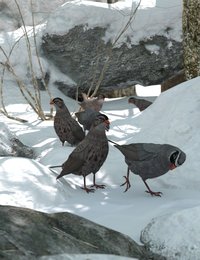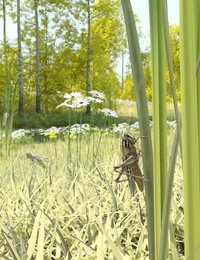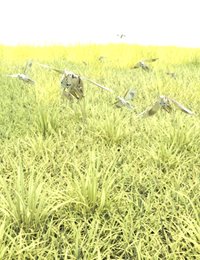Extinct? Himalayan Quail have not been seen with certainty since 1876, despite a number of searches. Thorough surveys are still required. It has been severely impacted by hunting and habitat degradation. While it hasn’t been seen (officially recorded) in about 150 years, it is believed that it probably remains extant. This is because the species is difficult to detect (favoring dense grass and being reluctant to fly). In addition, there is a recent set of possible sightings around Naini Tal in 2003. But any remaining population is likely to be tiny, and for these reasons, it is treated as Critically Endangered.
The species was last seen 60 years before independence, indicating that hunting levels during the colonial period contributed significantly to its decline. Widespread land-use changes thereafter, particularly open cast mining for limestone and related disturbance, are other likely contributory factors to its decline. Its contact call was apparently heard frequently in November and appears to have aided hunters to locate them. It is also hypothesized that habitat changes at lower elevations during the post-Pleistocene glaciation might have pushed sub-populations to sub-optimal higher elevations, causing local extinctions.
There have been a number of official and unofficial attempts to rediscover the species, covering some of the most suitable areas around Mussoorie and Naini Tal. However, none has yet been successful. In 2002 and 2010, surveys used posters, interviews with locals and habitat analyses to direct field searches, but failed to find definitive evidence of the species. Further surveys involving local communities are planned. The potential distribution of the species has been mapped, based on the habitat requirements of two similar species: Cheer Pheasant (Catreus wallechi) and Himalayan Monal (Lophophorus impejanus). This work identified five large areas of potentially suitable habitat in Uttarakhand, India which should be surveyed. The same study suggested that the species could still be extant, with an estimated year of extinction of 2023.
It has only been recorded in 2 locations (and 12 specimens) in the western Himalayas in Uttarakhand, north-west India.
The species was last seen 60 years before independence, indicating that hunting levels during the colonial period contributed significantly to its decline. Widespread land-use changes thereafter, particularly open cast mining for limestone and related disturbance, are other likely contributory factors to its decline. Its contact call was apparently heard frequently in November and appears to have aided hunters to locate them. It is also hypothesized that habitat changes at lower elevations during the post-Pleistocene glaciation might have pushed sub-populations to sub-optimal higher elevations, causing local extinctions.
There have been a number of official and unofficial attempts to rediscover the species, covering some of the most suitable areas around Mussoorie and Naini Tal. However, none has yet been successful. In 2002 and 2010, surveys used posters, interviews with locals and habitat analyses to direct field searches, but failed to find definitive evidence of the species. Further surveys involving local communities are planned. The potential distribution of the species has been mapped, based on the habitat requirements of two similar species: Cheer Pheasant (Catreus wallechi) and Himalayan Monal (Lophophorus impejanus). This work identified five large areas of potentially suitable habitat in Uttarakhand, India which should be surveyed. The same study suggested that the species could still be extant, with an estimated year of extinction of 2023.
It has only been recorded in 2 locations (and 12 specimens) in the western Himalayas in Uttarakhand, north-west India.









